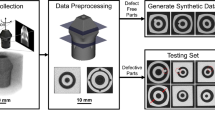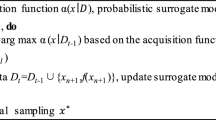Abstract
Accurate and quick detection has a significant bearing on overall productivity of remanufacture. 3D scanning technologies have been widely applied in defects detection by comparing the damaged model with the nominal model. In this process, a huge amount of point cloud data is required to ensure detection accuracy whereas resulting in large storage space and long processing time of detection. This paper proposed an efficient two-step method based on octree to detect defects accurately and quickly for remanufacturing. In this method, the damaged point cloud and the nominal point cloud are first registered. Then a two-step detection approach is developed to extract the surface defects, coarse detection and detailed extraction, where the octree method is applied to create an effective topology of discrete points and perform the Boolean operation for defects extraction. In coarse detection, rough location and size information of the defects are acquired from the whole point cloud data. Based on coarse detected boundary box containing defects, the detailed extraction step is applied to extract corresponding defects shape accurately. The feasibility of proposed method was validated by using a case to detect defects of a damaged turbine blade and the detection results can be used to generate restoration tool path. The results show that the proposed method outperforms state-of-art defects detection methods, which can reduce time by 74.03% and reduce error by 36.86%, respectively.

























Similar content being viewed by others
References
Du, Y., Cao, H., Fei, L., Li, C., & Xiang, C. (2012). An integrated method for evaluating the remanufacturability of used machine tool. Journal of Cleaner Production, 20(1), 82–91.
Li, Y., Huang, H., Qingsheng, X., et al. (2018). Research on a surface defect detection algorithm based on mobilenet-ssd. Applied Sciences, 8, 1678.
Wilson, J. M., Piya, C., Shin, Y. C., Fu, Z., & Ramani, K. (2014). Remanufacturing of turbine blades by laser direct deposition with its energy and environmental impact analysis. Journal of Cleaner Production, 80(1), 170–178.
Yza, B., Jin, L., Hw, C., Mr, D., Mza, B., Wla, B., et al. (2021). An intelligent and automated 3d surface defect detection system for quantitative 3d estimation and feature classification of material surface defects. Optics and Lasers in Engineering, 144, 106633.
Zhang, X., Cui, W., & Liou, F. (2021). Voxel-based geometry reconstruction for repairing and remanufacturing of metallic components via additive manufacturing. International Journal of Precision Engineering and Manufacturing-Green Technology, 8, 1663.
Rannou, G., Thierry, D., & Lebozec, N. (2010). Ultrasonic monitoring of steel corrosion during accelerated corrosion testing and outdoor field exposures. In: NACE Corrosion 2010 Conference & Expo 2010. National Association of Corrosion Engineers, USA, pp. 1–14.
Zolfaghari, A., Zolfaghari, A., & Kolahan, F. (2018). Reliability and sensitivity of magnetic particle nondestructive testing in detecting the surface cracks of welded components. Nondestructive Testing and Evaluation, 33, 1–11.
Zolfaghari, A., & Kolahan, F. (2017). Reliability and sensitivity of visible liquid penetrant ndt for inspection of welded components. Materialprufung, 59(3), 290–294.
Xu, C., Guo, J., Zhou, X., Chao, W., Dong, L. (2017). An edge sensitive 3D measurement using two directional laser stripes scanning with a laser projector. In: Proceeding SPIE 10410, Unconventional and Indirect Imaging, Image Reconstruction, and Wavefront Sensing (Vol. 1041010). https://doi.org/10.1117/12.2276848.
Skrodzki, M., Jansen, J., & Polthier, K. (2018). Directional density measure to intrinsically estimate and counteract non-uniformity in point clouds. Computer Aided Geometric Design, 64(Aug), 73–89.
Yilmaz, O., Gindy, N., & Jian, G. (2010). A repair and overhaul methodology for aeroengine components. Robotics and Computer Integrated Manufacturing, 26(2), 190–201.
He, J., Li, L., & Li, J. (2011). Research of key-technique on automatic repair system of plane blade welding. In IEEE.
Zhang, X., Li, W., Adkison, K. M., & Liou, F. (2018). Damage reconstruction from tri-dexel data for laser-aided repairing of metallic components. The International Journal of Advanced Manufacturing Technology, 96, 3377.
Liu, T., Wang, N., Fu, Q., Zhang, Y., & Wang, M. (2019). Research on 3D reconstruction method based on laser rotation scanning. In 2019 IEEE international conference on mechatronics and automation (ICMA). IEEE.
Chao, F., Jin, L., Gong, C., Wenyan, P., & Liu, S. (2018). Repair volume extraction method for damaged parts in remanufacturing repair. International Journal of Advanced Manufacturing Technology, 98, 1–14.
Shi, B. Q., Jin, L., & Liu, Q. (2011). Adaptive simplification of point cloud using k-means clustering. Computer-Aided Design, 43(8), 910–922.
Chien, C. H., & Aggarwal, J. K. (1986). Volume/surface octrees for the representation of three-dimensional objects. Computer Vision Graphics and Image Processing, 36(1), 100–113.
Piya, C., Wilson, J. M., & Murugappan, S., et al. (2011). Virtual repair: Geometric reconstruction for remanufacturing gas turbine blades[C]. In ASME international design engineering technical conferences and computers and information in engineering conference.
Bremer, C. (2005). Automated repair and overhaul of aero-engine and industrial gas turbine components[C]. In: Asme turbo expo: Power for land, sea, & air.
Xiao, W., Liu, G., & Zhao, G. (2020). Generating the tool path directly with point cloud for aero-engine blades repair. Proceedings of the Institution of Mechanical Engineers Part B Journal of Engineering Manufacture, 235(2), 095440542097091.
Lin, A. C., & Liu, H. T. (1998). Automatic generation of nc cutter path from massive data points. Computer-Aided Design, 30(1), 77–90.
Zou, Q., & Zhao, J. (2018). Iso-parametric tool path planning for point clouds. Computer Aided-Design, 45, 1459–1468.
Biegler, M., Wang, J., Kaiser, L., & Rethmeier, M. (2020). Automated tool-path generation for rapid manufacturing of additive manufacturing directed energy deposition geometries. Steel Research International, 91, 2000017.
Elseberg, J., Borrmann, D., & Nuechter, A. (2013). One billion points in the cloud: an octree for efficient processing of 3d laser scans. ISPRS Journal of Photogrammetry and Remote Sensing, 76(Feb), 76–88.
Renwei, L., Zhiyuan, W., & Liou, F. (2018). Multifeature-fitting and shape-adaption algorithm for component repair. Journal of manufacturing science and engineering: Transactions of the ASME, 140(2), 1–19.
Lowe, D. G. (2004). Distinctive image features from scale-invariant keypoints. International Journal of Computer Vision, 60(2), 91–110.
Li, P., Wang, J., Zhao, Y., Wang, Y., & Yao, Y. (2016). Improved algorithm for point cloud registration based on fast point feature histograms. Journal of Applied Remote Sensing, 10(4), 045024.
Xie, Y., Tian, J., & Zhu, X. X. (2020). Linking points with labels in 3D: A review of point cloud semantic segmentation. In: IEEE Geoscience and Remote Sensing Magazine (Vol. 8, no. 4). pp. 38–59. https://doi.org/10.1109/MGRS.2019.2937630.
Acknowledgements
This study was supported the National Natural Science Foundation of China (Grant no. 52175453); Chongqing General Program of Natural Science Foundation (Grant no. cstc2020jcyj-msxmX0639); the Fundamental Research Funds for the Central Universities, China (Grant No. 2020CDJ-LHZZ-060).
Author information
Authors and Affiliations
Corresponding author
Ethics declarations
Conflict of interest
The authors declare that they have no conflict of interest.
Additional information
Publisher's Note
Springer Nature remains neutral with regard to jurisdictional claims in published maps and institutional affiliations.
Rights and permissions
About this article
Cite this article
He, Y., Ma, W., Li, Y. et al. An Octree-Based Two-Step Method of Surface Defects Detection for Remanufacture. Int. J. of Precis. Eng. and Manuf.-Green Tech. 10, 311–326 (2023). https://doi.org/10.1007/s40684-022-00433-z
Received:
Revised:
Accepted:
Published:
Issue Date:
DOI: https://doi.org/10.1007/s40684-022-00433-z




